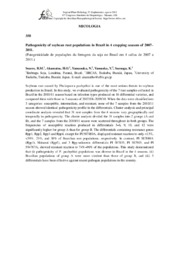Pathogenicity of soybean rust populations in Brazil 4 cropping seasons 2007 - 2011.
Pathogenicity of soybean rust populations in Brazil 4 cropping seasons 2007 - 2011.
Author(s): SOARES, R. M.; AKAMATSU, H. O.; YAMANAKA, N.; YAMAOKA, Y.; SUENAGA, K.
Summary: Soybean rust caused by Phakopsora pachyrhizi is one of the most serious threats to soybean production in Brazil. In this study, we evaluated pathogenicity of the 7 rust samples collected in Brazil in the 2010/11 season based on infection types produced on 16 differential varieties, and compared them with those in 3 seasons of 2007/08?2009/10. When the data were classified into 3 categories: susceptible, intermediate, and resistant, none of the 7 samples from the 2010/11 season showed identical pathogenicity profile in the differentials. Cluster analysis and principal coordinate analysis revealed that 31 rust samples from the 4 seasons vary geographically and temporally in pathogenicity. The cluster analysis divided the 31 samples into 2 groups (A and B), and the 7 samples from the 2010/11 season were scattered throughout in both groups. The frequencies of susceptible reaction produced in differentials 3?6, 9, 10, and 12 were significantly higher for group A than for group B. The differentials containing resistance genes Rpp1, Rpp2, Rpp3 and Rpp4, except for PI 587880A, displayed resistant reaction to only <13%, <39%, 23%, and 38% of Brazilian rust populations, respectively. In contrast, PI 587880A (Rpp1), Shiranui (Rpp5), and 3 Rpp-unknown differentials PI 587855, PI 587905, and PI 594767A, showed resistant reaction to 74%?96% of the populations. This study demonstrated that (i) pathogenicity of P. pachyrhizi populations was diverse in Brazil in the 4 seasons, (ii) Brazilian populations of group A were more virulent than those of group B, and (iii) 5 differentials have been effective against recent pathogen populations in the country.
Publication year: 2012
Types of publication: Abstract in annals or event proceedings
Unit: Embrapa Soybean
Keywords: Fitopatologia
Observation
Some of Embrapa's publications are published as ePub files. To read them, use or download one of the following free software options to your computer or mobile device. Android: Google Play Books; IOS: iBooks; Windows and Linux: Calibre.
Access other publications
Access the Agricultural Research Database (BDPA) to consult Embrapa's full library collection and records.
Visit Embrapa Bookstore to purchase books and other publications sold by Embrapa.

